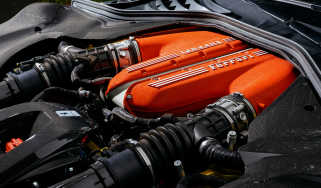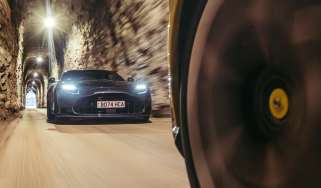Ferrari 250 GTO: the history, specs, prices and hype of an automotive icon
In the world of front-engined Ferraris, one stands above all others. But can the 250 GTO really justify the hype – and the stratospheric values? We asked someone who really knows
There’s a picture on the wall in one of Goodwood’s briefing rooms, showing a Ferrari 250 GTO and a Zagato Aston DB4 GT in close embrace against the Madgwick banking. Both cars are significantly damaged, and not by amateurs out of their depth, but by the very best in the world, as in Jim Clark and John Surtees. It was 1962 and the Tourist Trophy; Clark had spun the Aston and Surtees – who was leading the race – had collected him. Both cars were then later clouted by Robin Benson’s errant Ferrari 250 SWB.
So let’s get this out of the way early on. Today, that’s a car park with a value heading towards 100 million. Dollars or pounds, it doesn’t much matter, and, assuming you bought as seen, the cost of any repairs would be completely incidental. Perhaps less so then: Maranello already knew how to add the noughts…
Trouble is, the noughts are really all most casual onlookers want to know about, but it does beg the question, how did it get to that? Editor Barker asked the slightly more penetrating question – is there some magic ingredient available only from a GTO’s driving seat, something that makes it actually worth the money? The short answer is no – of which more in a moment – but, as a driver today, the numbers are a detail you really have to banish from the mind.
> Ferrari Testarossa review, history and specs: TR generations driven back-to-back
I’ve driven a great many racing miles in a GTO and I just don’t think about values. You can’t if you’re going to get on with it. They certainly didn’t think about it then either. To Graham Hill, or John Surtees or Phil Hill, a GTO was just a tool to get the job done on that day. If it got bent, someone would straighten it.
If the engine took a Big Rev, someone would put in another one. Surtees is even on record saying that he really didn’t want to drive a GTO. The bloody thing was underpowered and if you set up to carry speed through the corners, you were likely to hit a Lotus Elite or an MGA, or anything else that got in the way. So there’s our first clue.
The GTO was an evolution of the 250 GT SWB (the ‘O’ was for ‘Omologato’) an upgrade overseen mainly by young upstart Giotto Bizzarini, then working for Ferrari before he and several others were unceremoniously sacked in 1962 when they dared to challenge the Great Man. Ferrari had seen the threat coming from Shelby’s Cobra and Jaguar’s E-type and thought he might do something fairly simple to extend the racing life of the 250, so he could sell them to wealthy amateurs. He had allegedly said something like, ‘well, if you think you’re so clever, see what you can do with the 250...’ Wind tunnel testing was carried out at Pisa university, after which stylist and bodymaker Sergio Scaglietti lengthened and lowered the nose, stretched the tail and closed in the underside with a full-length belly pan. The drag-reducing flip up on the boot was added shortly afterwards. Carroll Shelby would do much the same to the Cobra to create the Daytona and most of it was an attempt to improve straight-line speed for Le Mans.
Bizzarini used the single-cam 3-litre V12 engine from the Le Mans-winning Testa Rossa, complete with dry-sump lubrication (the GTO’s oil tank is in the boot) and six downdraught Webers, pushing out just under 300bhp at about 8000rpm. There was a new five-speed gearbox featuring Porsche-type synchromesh and with the signature slotted gate that would be a Ferrari cabin essential until paddle shifts were invented. The rest was pretty standard 1950s fare. The chassis was a simple steel ladder (more of that in a moment, too) and the beam back axle was suspended on cart springs and located by a Watt’s link. At the front there were pressed steel wishbones and coil springs – just like you find on a Mk4 Cortina – and there were telescopic dampers all round. At least there was a disc inside each Borrani wire wheel.
Of the main competitors, the Cobra was out of a similar basic design mould – ladder chassis, aluminium body perched on top – but it used an engine that was half as big again. The E-type was a great deal more sophisticated than either. A monocoque tub was a much more rigid structure on which to hang all-round independent suspension and you sat low with legs outstretched looking along that expanse of bonnet. Only the dozen factory lightweights, though, had the aluminium tub and body, and the aluminium block for the straight-six engine. Which makes the superleggera Jaguar three times rarer than the Ferrari...
In period, though, the GTO definitely had some good points. It was light (just over 1000 kilos all up), the compact V12 sat low and well towards the centre of the car, it had the extra gear in the box when most had only four, and it all slipped through the air thanks to the body shape. Perhaps more importantly, it offered two very important, traditional Ferrari traits.
It had great stamina and was extremely reliable. The first competition E-types weren’t. GTO reliability didn’t come cheap though. In 1962, a GTO cost about £6000, or the price of a sizeable house in Surrey. A showroom E-type was £2000 and a Cobra £2500.
The period results are easier to quantify than the modern ones. Only 39 GTOs were built and almost exclusively they were used as race cars, not least because they were hot and noisy and offered few creature comforts; Enzo Ferrari’s strategy proved sound and he won the International Manufacturers’ Championship for GTs in 1962, ’63, and ‘64, in all of which the GTO was a key player.
Chassis no. 3757 , now owned by Nick Mason, was purchased new by Belgian race team Ecurie Francorchamps in 1962 and almost immediately driven to third overall at the Le Mans 24 Hours. The following year, it went one better and finished second, driven again by semi-professional drivers. The car has raced every year of its life since then, more recently including several Goodwood Revivals with yours truly. It’s what the car was made for, and in 2011 Martin Brundle and I took a good second in pouring rain. The rain, though, is another clue. When I try to answer the first question – whether there’s any magic ingredient – the finer details of historic racing in the modern era might help to explain.
> Ferrari F40 vs 288 GTO - turbocharged icons go head-to-head
In period, and just like its rivals, a GTO sat high on relatively soft suspension. That’s how they came from the factory and most owners simply took delivery and went racing. They did that on tracks that were often bumpy and featured few really tight corners: these have been added in large numbers mainly to slow down modern formula cars with huge amounts of grip that could do a whole lap near enough flat-out. The suspension allowed the good guys to manipulate the GTO’s weight – which is low, with the major masses closer to the centre – and shift the car’s balance to where it was needed.
Approach, say, Madgwick at Goodwood – a rare instance of a track whose layout hasn’t changed since 1950 – probably in fourth gear, brush the brake and ease the steering right. The weight shifts to the front and the car starts to rotate. The critical thing, though, is that you must be travelling about 10mph faster than you reckon the car can cope with, or, in other words, fast enough that it won’t make the corner unless you do everything right. The car begins to turn, but it’s important to resist the instinct to nab it immediately and correct with steering. Let it yaw and then bring in the power. That settles the weight back towards the rear tyres and stops the car sliding, at the same time driving it forwards and maintaining momentum. Most importantly, it shares out the cornering loads more equally among four tyres rather than two. This deals with the extra 10mph, which is then yours all the way down the next straight.
You might need a bit of management with the steering as you go, but only a bit, and you mustn’t lift the right foot. Graham Hill was a great exponent – note how, in the picture above, the car is at a significant angle but the front wheels are straight. You had to have good car control, and the confidence that it would work, and, having set it all up, you can see why Surtees would be reluctant to lift off and lose the momentum. He would just hope to miss the Elite, and if he didn’t, well, it meant he could get home early... And it wasn’t just the GTO that was driven like this. There’s a picture of Jim Clark in the Aston at an angle of nearly 45 degrees but with the merest hint of corrective lock. It was taken at Fordwater, the fastest corner at Goodwood. Which begs the obvious question: why aren’t the cars driven like that now?
The main reason is simply that modern cars aren’t driven like that, and modern tyres are not designed to withstand constant drifting. As tyres improved, they gripped rather than slipped, while the brakes gained stamina as well as power. You don’t hear so much about the quality of brakes in the 1960s, but you do pick up the odd clue from autobiographies. The good guys worked out pretty quickly that you couldn’t use them hard for long, so they found other ways of losing speed. And the circuits changed. The modern way is to keep the front loaded and take the braking deeper into a tight corner. That maintains straight-line speed for longer and takes a shorter route through the turn. The driver accepts that mid-corner pace might be slightly lower, but it’s more than compensated on the way in.
Cars began to sit ever lower, and suspension became stiffer, mainly to prevent the effects of extreme weight transfer as brakes and tyres improved. The GT minimum ride height has been 100mm for a long time, but in 1962, nobody attempted to reach it; just study the pictures of an E-type’s rear wheel then and now. In the ‘60s, there was space between the arch and the top of the tyre. Now the wheel is half covered. Modern thinking has been applied to historic race cars, and there’s no doubt that modern brake materials have also improved the performance of historic brakes. The GTO, though, does not respond in the same way. You can stiffen up an E-type’s suspension because the monocoque is rigid enough to stand it. When we tried a bigger front anti-roll bar on Nick’s GTO, the windscreen popped out at the edges...
There is also the question of engines. John Surtees thought Ferrari engines were better in period than today. That could be because they were closer to race spec when they left the factory, but perhaps also because they were more expendable. A GTO engine was comparatively rare even when it was new and, if you can find one, it will now fetch six figures, which rather restricts development. The Jaguar sixes, and especially the 4.7-litre Ford V8 in the Cobra were fitted to many different models over the years and were made in large numbers. The Ford, in particular, has been constantly developed ever since.
As a package, the GTO worked because it was reliable and it had a good balance, which a good driver could exploit to good effect, but it was obsolete at International level by the mid-60s. After his first outing in Nick’s car, Martin Brundle observed that the main problem was that we were up against race cars, which by comparison Nick’s GTO ‘absolutely wasn’t’. I like it for that, though, because it’s a real snapshot of how things might have been. That and the chassis balance and soft suspension, which allows you to have a crack at the Old Way, and the click and clack of the long gearlever in its slotted gate, and, of course, the noise. There’s nothing quite like a V12’s wail, especially when it’s sat right in front of you...
Ferrari 250 GTO
| Engine | V12, 2953cc |
| Max power | c300bhp @ 8000rpm |
| Max torque | n/a |
| Transmission | Five-speed manual, rear-wheel drive |
| Steering | Worm-and-roller, unassisted |
| Brakes | Solid discs front and rear |
| Wheels | 6.00 x 15in front, 7.00 x 15in rear, wire-spoke |
| Weight | c1000kg |
| Power to weight | c305bhp/ton |
| 0-60mph | c6.0sec (est) |
| Top speed | c170mph |
| Value today | £40,000,000+ |
This feature was first published in Enzo issue 4.






